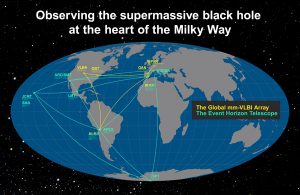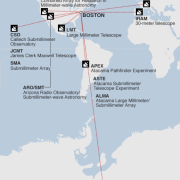ALMA joins the Global Millimeter VLBI Array (GMVA) and the Event Horizon Telescope (EHT)
The Atacama Large Millimeter/submillimeter Array (ALMA) joins for the first time the Global mm-VLBI Array (GMVA) and the Event Horizon Telescope (EHT), Earth-sized virtual observatories, which are made possible by an international collaboration of radio telescopes. One of the main drivers of this global collaboration is to study in detail the supermassive black hole at the center of our Milky Way. The GMVA will derive the properties of the accretion and outflow in the immediate surroundings of the Galactic Center, while the EHT will aim at imaging, for the very first time, the shadow of the black hole’s event horizon.
The impressive line-up of participating telescopes stretch across the globe, from the South Pole to Europe to Hawaii, and, of course, Chile. ALMA with its 66 antennas, state-of-the-art receivers, its excellent site and southern location make it the largest and most sensitive, as well as a strategic component of both the GMVA and EHT. The observations will be done with the GMVA from April 1 to April 4, 2017, and with the EHT from April 5 to April 14, 2017.

This infographic details the locations of the participating telescopes of the Global mm-VLBI Array (GMVA), and the Event Horizon Telescope (EHT). Their goal is to image, for the very first time, the shadow of the event horizon of the supermassive black hole at the centre of the Milky Way, as well as to study the properties of the accretion and outflow around the Galactic Centre. Credit: ESO/O. Furtak
The outcome of these observations is eagerly awaited by the community as its scientific potential is incredibly exciting. To help understand better these forthcoming observations, ALMA and its partners have launched a blog series to explain what the GMVA and EHT projects are and the science behind them. The series will take you along an astronomical journey, providing insight into how cutting-edge research is done, describe the associated risks, and provide answers to questions such as: How do radiotelescopes see the Universe? Why are black holes so interesting? What do we know about the supermassive black hole at the center of the Milky Way?
The outcome of these observations is eagerly awaited by the community as its scientific potential is incredibly exciting. To help understand better these forthcoming observations, ALMA and its partners have launched a blog series to explain what the GMVA and EHT projects are and the science behind them. The series will take you along an astronomical journey, providing insight into how cutting-edge research is done, describe the associated risks, and provide answers to questions such as: How do radiotelescopes see the Universe? Why are black holes so interesting? What do we know about the supermassive black hole at the center of the Milky Way?
The first installment explains the GMVA and EHT projects in more detail and what they may see. You can read it here.
(taken from ALMA announcement on Friday, 31 March 2017)







